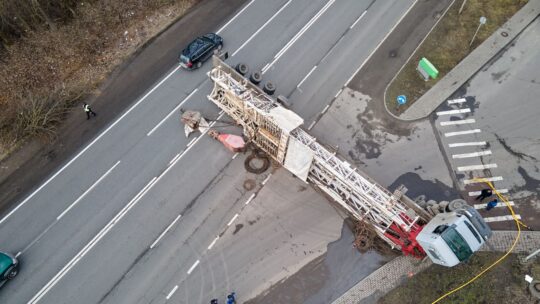
Rollover crashes represent some of the most devastating and deadly vehicle accidents, often resulting in severe injuries or fatalities even when other crash types at similar speeds produce minor damage. These accidents happen when vehicles tip beyond their stability limits and rotate around their horizontal axis, creating dangerous situations for occupants.
Road design features and excessive speed combine to create conditions where vehicles lose stability and flip or tip over during otherwise routine driving maneuvers. Understanding how infrastructure and driver behavior interact helps explain why certain roads and driving conditions produce disproportionate numbers of these catastrophic accidents.
The physics of vehicle stability involves complex interactions between road geometry, vehicle characteristics, and driving behavior that most people don’t understand until they’re involved in rollover accidents. Smart drivers learn to recognize dangerous conditions before they become victims of preventable crashes.
Road Features That Increase Rollover Risks
Sharp curves with inadequate banking force drivers to reduce speed dramatically or risk losing control when centrifugal forces overcome tire traction and vehicle stability systems. Many rural roads include curves that were designed decades ago for lower traffic speeds and don’t account for modern vehicle characteristics or traffic volumes.
Shoulder drop-offs create rollover hazards when vehicles leave the roadway and drivers overcorrect while trying to return to the pavement, causing sudden steering inputs that can trigger rollovers in top-heavy vehicles. These drop-offs are particularly dangerous for SUVs and trucks that have higher centers of gravity than passenger cars.
Construction zones often feature temporary barriers, lane shifts, and uneven surfaces that create unexpected handling challenges for drivers who aren’t prepared for changed road conditions. These work zones concentrate multiple risk factors including reduced space, confused traffic patterns, and unfamiliar road geometry.
Bridge approaches and overpasses sometimes include elevation changes and curve combinations that create challenging driving conditions, especially when ice, rain, or high winds add additional complexity to already demanding road geometry that tests vehicle stability limits.
The Role of Speed and Vehicle Dynamics
Excessive speed multiplies rollover risks by increasing the lateral forces that vehicles experience during turns, lane changes, and emergency maneuvers that would be safe at appropriate speeds. The physics of vehicle stability means that small speed increases can create disproportionately larger increases in rollover probability.
Vehicle center of gravity height affects rollover susceptibility dramatically, with taller vehicles like SUVs and trucks facing much higher rollover risks than lower passenger cars during identical driving situations. This physics reality means that certain vehicles require more conservative driving approaches to maintain safety margins.
Load distribution within vehicles changes center of gravity locations and affects stability characteristics in ways that most drivers don’t understand or consider when loading cargo or passengers. Improperly loaded vehicles can become unstable during routine maneuvers that would be safe with proper weight distribution.
Tire pressure and maintenance affect vehicle stability and handling characteristics that influence rollover susceptibility, with underinflated tires reducing the lateral forces that vehicles can handle before losing control. Regular tire maintenance becomes a crucial safety factor for preventing rollovers.
Environmental Conditions and Road Maintenance
Weather conditions including rain, snow, ice, and high winds reduce available traction while increasing the forces acting on vehicles, creating situations where rollover speeds drop significantly below normal limits. Wet roads can halve the lateral forces that vehicles can handle before losing stability.
Poor road maintenance creates surface irregularities, potholes, and drainage problems that can trigger vehicle instability during routine driving situations. These maintenance issues often develop gradually, making them less obvious to drivers who adapt slowly to deteriorating conditions.
Roadside hazards including ditches, trees, and barriers can trigger rollovers when vehicles leave the roadway and encounter sudden elevation changes or obstacles that cause rapid directional changes. Recovery from roadway departures often causes more severe accidents than the original incidents that caused vehicles to leave the road.

Visibility limitations from curves, hills, or vegetation can prevent drivers from seeing rollover hazards until they’re too close to avoid them safely, making advance warning systems and proper road design crucial for preventing accidents in challenging terrain.
Prevention Through Safer Design and Awareness
Engineering improvements including better curve banking, gentler shoulder slopes, and improved signage can reduce rollover risks by helping drivers understand road limitations and providing more forgiving environments when mistakes occur. These infrastructure investments often provide substantial safety benefits compared to their costs.
Speed limit setting should reflect actual road geometry and rollover risks rather than just general traffic management goals, with special attention to curves, hills, and other features that increase rollover susceptibility for different vehicle types that use the roads.
Driver education about vehicle stability, load limits, and environmental factors can help prevent rollovers by teaching people to recognize dangerous conditions and adjust their driving accordingly. This education should emphasize the physics differences between vehicle types and how they affect safe driving practices.
Vehicle safety technology including electronic stability control, rollover sensors, and improved roof strength helps prevent rollovers and protect occupants when they do occur, but these systems can’t overcome poor driving decisions or inadequate road design that exceeds their capabilities.
Conclusion
Understanding rollover risks helps drivers make informed decisions about speed and vehicle handling while recognizing road conditions that require extra caution. These accidents often result from combinations of factors rather than single causes, making awareness and preparation crucial for prevention.
Road design improvements and driver education can significantly reduce rollover accident rates when they address the underlying factors that create dangerous conditions rather than just responding to accidents after they occur. Proactive safety approaches cost less than reactive responses to preventable tragedies.
Smart drivers adjust their behavior based on road conditions, vehicle characteristics, and environmental factors while supporting infrastructure improvements that make roads safer for everyone. Prevention through safer design and awareness protects entire communities rather than just individual drivers.


















